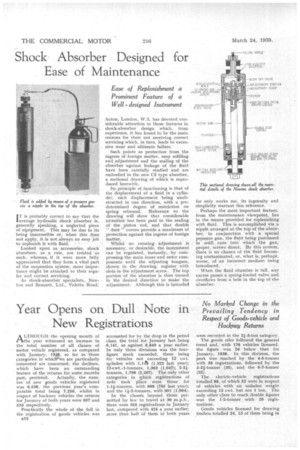Year Opens on Dull Note in
Page 38

Page 39

If you've noticed an error in this article please click here to report it so we can fix it.
New Registrations
No Marked Change in the Prevailing Tendency in Respect of Goods-vehicle and Hackney Returns
ALTHOUGH the opening month of the year witnessed an increase in the total number of all classes of motor vehicle registered, as compared with January, 1938, so far as those categories in whicIeWe are particularly interested are concerned, the declines, which have been an outstanding feature of the returns for some months past, persisted. Actually, the number of new goods vehicles registered was 6,538, the previous year's comparable total being 7,256, whilst in respect of hackney vehicles the returns for January of both years were 507 and 533 respectively.
Practically the whole of the fall in the registration of goods vehicles was 812
accounted for by the drop in the petrol class, the total for January last being 6,141, as against 6,849 a year earlier. In only three divisions was the fourfigure mark exceeded, these being for vehicles not exceeding 12 cwt. unladen with 1,1113 (1,322 last year); 12-cwt.-1-tormers, 1,363 (1,047); 2-2ktonners, 1,798 (2,297). The only other categories in which registrations of note took place were those for 1-4-tonners, with 606 (755 last year); and the 4-2-tonners, with 901 (1,004).
In the classes beyond those per. mitted by law to travel at 30 m.p.h., there were 355 registrations in January last, compared with 424 a year earlier; more than half of them in both years were recorded in the 2I-3-ton category.
The goods oiler followed the general trend and, with 176 vehicles licensed, the figure was 24 below that for January, 1938. In this division, the peak was reached by the 4-5-tonner with 36 registrations, followed by the 2-21--tonner (35), and the 6-7-tonner (32).
The electric-vehicle registrations totalled 88, of which 52 were in respect of vehicles with an unladen weight exceeding 12 cwt. but not 1 ton. The only other class to reach double figures was the 1-2-tonner with 20 registrations.
Goods vehicles licensed for drawing trailers totalled 24, 13 of them being in the section for machines exceeding 4 tons. The total for the comparable month of last year was 32.
In the four classes into which multiwheeled vehicles are divided there were falls, the most pronounced being noted in the eight-wheeler class, the 22 registrations in which contrasted with 45 in January, 193s. The five-wheeler (mechanical-horse pattern) was also a dull spot, with 31 registrations against 56 a year earlier. In the case of sixWheelers, both of the rigid-frame and articulated types, there was much more stability about the totals, although the former fell by 5 to 60 and the latter by 6 to 54.
The total for agricultural vans and lorries was 124 vehicles, compared with 109 in January, 1938, whilst under the heading of agricultural engines (5s. class) 503 ploughing machines, etc.. were licensed, against 583 a year
earlier. So far as tractors are concerned, 31 machines were registered„
in the proportion of 13 agricultural and 18 for general haulage.
Government-owned vehicles continue to account for most of the exempt vehicles, and the figure of 1,683 for January last has to be set against 1,944 for January, 1938. In respect of all exempt vehicles, the total was 1,773, the figure for last year being higher at 2,035.
Of the total of 507 hackneys licensed in January last, 82 were trolleybuses, 235 petrol vehicles and 190 oilers. The first-named shows a material increase on last year's total of nine, largely because 77 vehicles with a seating capacity exceeding 64 persons were registered. Very little change took place in the petrol hackneys, the main reason for the small fall in the division being due to the registration of fewer taxicabs. The hackney oiler took a tumble, mainly because the total for the 48-56-seater machines, at 90, was halved.
Incidentally, the returns for January Oxhide, in the hackney-oiler total, a coal-gas-driven machine. A further noteworthy feature of the hackneys is that 77 vehicles were six-wheelers, whereas the comparable return in January, 1938, was 14 vehicles_




















































































